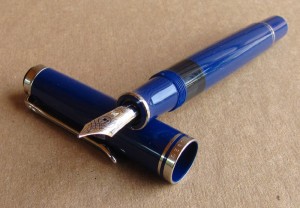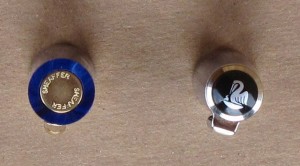Side by Side: Pelikan M605 vs. Sheaffer No Nonsense
August 27, 2011
While reorganizing my collection of fountain pens recently, I was struck by the similarities, at first glance, between my new Pelikan Souverän M605 and my early 90’s Sheaffer No Nonsense. These pens are in fact quite different from one another, but it is interesting to compare them nonetheless.
That these pens look so similar at first is because they are almost exactly the same size and shape. Furthermore, the blue colour of this particular No Nonsense is very similar to that of the M605, although the lighter parts of the Sheaffer’s marbled plastic set them apart.
A closer look at both pens reveals a noticeable difference in quality. The M605‘s resin (plastic) barrel, section, and cap are completely smooth and polished to a high shine. The section is the same blue colour as the rest of the pen. The No Nonsense on the other hand, while still shiny, is noticeably duller, and there are mold seams visible on both the threaded part of the barrel, and the black plastic section.
The Pelikan’s clip is a single piece of metal with an integrated ring which is held in place by the cap top, whereas the Sheaffer’s clip is simply embedded into the plastic near the top of the cap, an arrangement that could work loose over time.
The Pelikan is trimmed with a double ring at the base of the cap, a double ring on the filler knob, and a fine single ring at the end of the section. The rings, as well as the clip and cap top, are all palladium plated. (I’ve seen the M605 advertised as having silver, rhodium, and even chrome plated trim, but the word directly from Pelikan in Germany is that it is in fact plated with palladium.)
The Sheaffer’s much simpler furniture, a single wide ring at the base of the cap, a flat insert in the cap top, and the clip, are gold plated. The cap top and clip are both inscribed with the Sheaffer name.
Capped, uncapped, and posted, both of these pens have almost identical dimensions. The Pelikan M605 is 134mm long capped, 124mm uncapped, 155mm posted, has a barrel diameter just behind the section of 12mm, and weighs about 18g. The Sheaffer No Nonsense is 132mm capped, 122mm uncapped, 156mm posted, 12mm in diameter, and weighs 15g.
The most notable dimensional difference is that the Sheaffer’s uncapped length, not including the nib, is longer than the Pelikan’s, while the nib itself is shorter.
The nibs themselves are probably the biggest differentiators between these two pens. The M605 is equipped with a 14 carat gold nib with rhodium plating giving a two-tone gold and silver finish. The nib is embossed with the Pelikan logo and some curlicues. The Pelikan nib also has a pronounced widening from the section outward, before tapering to a point, giving the classic fountain pen look. The No Nonsense nib is stainless steel with gold plating, and is less elaborately decorated than the Pelikan’s. It also has much straighter sides when viewed from above.
Both nibs write exceptionally smoothly, an attribute shared with all of my Pelikan pens, but only some of my Sheaffer pens. Both nibs are Fine, but the Pelikan nib has slightly more flow, resulting in a line more like that of my Medium-nibbed Sheaffer pens, especially on average quality paper (the sample below was written on Rhodia paper, which is less absorbent than most and thus produces a finer line).
The two pens have two very different filling systems. The M605 is a traditional fountain pen, designed to be filled from an ink bottle. It is a piston-filler, which is filled by inserting the nib into the ink, unscrewing the filler knob to push the piston to the bottom of the ink chamber and expel all the air, and then screwing the knob back in to retract the piston and suck ink into the pen. The transparent ink window shows about half the 1.5mL reservoir and lets you see how much ink is left (you can also see the piston during the filling operation).
Filling the No Nonsense is done by unscrewing the barrel from the section and inserting an ink cartridge. Screwing the barrel back on pushes the cartridge onto a metal nipple, which pierces the end of the cartridge. Sheaffer has their own proprietary cartridges, but most of their pens use them, so they are readily available, even today. Each cartridge holds about 1mL of ink. The only way to see how much ink is remaining is to unscrew the barrel and look at the cartridge.
The Pelikan Souverän M600 series of pens are not inexpensive, with a suggested retail price of 275€ (about $350). However, the M605 in particular is much less costly. It was originally produced as an export-only model but apparently did not sell well, so the stock was bought up by the Galeria Kaufhof department store chain in Germany, which has been selling them for 99€ (about $130) for several years now. The M605 is a great way to get a top-quality pen for a good price.
The Sheaffer No Nonsense series is on the other end of the price scale. Introduced in the 1970s, the original retail price was $1.98 (about 1.50€, although the Euro didn’t exist at that time), which included two ink cartridges. The particular No Nonsense in this article was an up-scale model, with the marbled plastic and gold trim, but I do not know what its original price was. I purchased it as new old-stock for $25 early this year. I suspect the original price was in the $5 to $10 range.
In the long run, the Pelikan will be cheaper. A 60mL bottle of ink costs about $9, whereas a package of five Sheaffer cartridges (5mL total) costs about $8. To buy 60mL of ink in cartridges will thus cost about $96. After two bottles of ink or 120 cartridges, the Pelikan will already be more economical (not to mention, more environmentally sound).
Related Articles
If you've found this article useful, you may also be interested in:

If you've found this article useful, consider leaving a donation in Stefan's memory to help support stefanv.com
Disclaimer: Although every effort has been made to ensure accuracy and reliability, the information on this web page is presented without warranty of any kind, and Stefan Vorkoetter assumes no liability for direct or consequential damages caused by its use. It is up to you, the reader, to determine the suitability of, and assume responsibility for, the use of this information. Links to Amazon.com merchandise are provided in association with Amazon.com. Links to eBay searches are provided in association with the eBay partner network.
Copyright: All materials on this web site, including the text, images, and mark-up, are Copyright © 2025 by Stefan Vorkoetter unless otherwise noted. All rights reserved. Unauthorized duplication prohibited. You may link to this site or pages within it, but you may not link directly to images on this site, and you may not copy any material from this site to another web site or other publication without express written permission. You may make copies for your own personal use.








Amberlea Davis
March 17, 2012
Nice comparison. Don’t forget that the Sheaffer does have a converter so you can use bottled inks. The biggest draw of the Pelikan is that you can fill it with LOTS of ink. I have an antique Sheaffer I used on college, a cartridge would last one day. The Pelikan fill would last a week. Though I am a dedicated bottled ink user…..I still use my Sheaffers more than my Pelikans.
Stefan Vorkoetter
March 17, 2012
Is there something about the Sheaffers that makes you prefer them over the Pelikans? I find that I’m the exact opposite, preferring the feel of the Pelikans.
Sandro Dunatov
February 22, 2013
I too own many Pelikans and some Sheaffers, the no-nonsense was my nightmare at schol when I was 10-12 , Pelikans work much better, better nibs, better caps, better pens. I prefer my 1.- Eur NOS Pelikano to my No-nonsenses, not to speak of Souverans. The M605 is really great (M600 too, maybe eevn better, with the amazingly striped body).
Stefan Vorkoetter
March 03, 2013
Yes, the Pelikan M605 is definitely the better quality pen. However, having had a few No-Nonsenses and a few Pelikanos too, I can’t really say one is better than the other. My Pelikanos are nice, but so are the No-Nonsense pens (especially the one that was the subject of this article).
CSharp
January 09, 2014
In addition to the converter mentioned by Amberlea Davis, NoNonsense pens can be made into eyedroppers by adding silicone grease to the threads. I just did it with a NOS NN calligraphy pen recently and I’m not the only one who’s done it.
Re: the mold seams on the NN–I have a Pelikan M200 and a 90s M250. Both have mold seams on the sections. A little harder to see than on my 2 NN pens, but they are there.
Now that I look at all four pens closely, the seams are harder to see on the section of the NOS NN I have than even the Pelikans. It’s from the Sheaffer Eaton Textron era. My other NN is a pink one that I’ve seen described as a Gemtone even though the packaging I’ve seen for this color didn’t say “Gemtone”. It’s become some kind of unofficial classification, apparently.